July 2004
Avez vous de pamplemousse?
-
Quebec, New Brunswick & Prince Edward Island

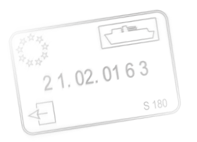


July 2004
Avez vous de pamplemousse?
Quebec, New Brunswick & Prince Edward Island
Or… Showdown at the OK Pa-neus!
FLASH! Technical advances! We are delighted to be able to send you this message much sooner than anticipated. Richard the Wonderful figured out how he could use a public access computer to send an already-prepared e-mail to a whole bunch of folks. Like most of what we are able to do in a technological sense this will seem pretty basic to many of you, but to us it qualifies as cutting edge communications.
In any case, we’re here, we’re having a splendid time swatting mosquitoes and snapping pictures, and are very happy. “O Canada” is truly a perfect anthem for this country. We’ve waited two years for the chance to come back and spend the summer in eastern Canada, and we have not been disappointed with our choice. Our aim was to be here by the end of June, and not leave until we either got bored or the snows started to fly.

We wandered into a very small border crossing, confused the guard so much she let us on through without much of an inspection (I don’t think she knew what to do with a motorhome that was trying to squeeze under her portico, and she didn’t speak any English), and there we were, voila! Two things became immediately apparent: it was incredibly beautiful and it was incredibly French. We were in the Province of Quebec. And our first impression has not changed: Quebec is lovely, and you will think you’ve crossed the big puddle and are in Europe. We had heard that this was the case, but still, the extent of the transformation was amazing.
We both speak a little French (merci, merci, Madame Rathmell for all that drilling in high school), Kathy more than Rick; we called this “Cereal Box French”; but Hello, Goodbye, Close the Window, and Open the Door only get you so far in any language. During the first couple of weeks we were usually able to find someone who spoke some English (invariably better than our French…..), and sign language still works for lots of things. But we were indeed surprised at just how French everything is. In other provinces of Canada, the signage is in both languages; not in Quebec. But guess what! The longer you stay, the more you remember from all that long time ago. We’ve done just fine, having progressed to the point where we could pose questions relatively easily (the problem came when they understood us and actually answered!). So, it was difficult to have a real discussion, but the basics could always be worked out. And everyone has been so very friendly. We had heard that the Quebecers were rude, difficult, unfriendly, etc. etc. We have not seen that. Fellow travelers in campgrounds are excited to view our motorhome, as it is generally larger and more interesting than theirs, and that gets the conversation started.
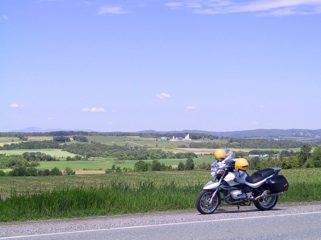
After a couple of days of catching our breath, we ventured out on the motorcycle to see the countryside, and it was lovely. The roads, so far, were just fine, although you really are waaaay out in the middle of nowhere very fast, and asphalt can turn to packed earth very quickly. There’s logging in the area, and trucks around sharp turns. We covered many miles of farm roads, passing through tiny hamlets, each with its own church. The churches were mostly of grey stone, with very steep spires, uniformly painted a bright aluminum silver. The fields were full of daisies, mustard, small burnt-orange flowers, and vetch. They are growing some corn and strawberries, as well as hay and Christmas trees. Apple trees are abundant in this area as well, with roadside stands promising cider in the fall. We call this area “steeples and silos country.” The homes are modest, neat and tidy, with flowers everywhere. As is most often the case, where winters are difficult, people plant flowers in the spring as soon as it is possible. We kept running across (almost literally) a small animal, both on the roads and even one in the campground. Too small for a beaver, but brown; maybe a marmot. We also saw raccoons, squirrels and chipmunks.

We were careful not to cross into Canada on July 1, which is Canada Day and quite equivalent to our July 4th; it makes border crossings more difficult. But June 23 is even more important in Quebec; it’s Jour St. Jean Baptiste; the whole province shuts down and has a party. There were fireworks, hot dog roasts, just like home …… and lots of garage sales; a typical four day holiday weekend.
One of the oddities of Quebec is that although most of the town names are in French, some are English. We were camped outside Compton, near Sherbrooke. Our mail was being sent to Ste-Luce, near Cap-Chat. You get the picture.
After a week in Compton we decided we were ready for more adventure, and headed toward Quebec City. But as we would be arriving in the midst of the holiday, we chose to see some of the country north of the city first, and head out the St. Lawrence Seaway a ways. So we skirted Quebec City and followed the seaway. The St. Lawrence is a really, really big river. About halfway to the ocean, it’s at least 10 miles wide. There are sights to be seen and cathedrals to visit, as you might expect; we were more interested in the countryside, as is usually the case, and enjoyed following the coastline along. We did make a one-night stop in Ste. Anne de Beaupre, where there is a famous basilica. We felt closer to Europe than ever. There was free camping in a grassy field owned by the church, and there must have been 30 vehicles of all sorts, just sort of parked every which way. After we were settled, we were joined by what was obviously a European rig. In chatting with the folks, who were German, we learned they had just shipped their small motorhome over from Bremerhaven to Halifax, and were setting out on a trip which would carry them to western Canada, then down the coast to California, before heading back to Germany from Baltimore at the end of October. They have traveled by rental motorhome in the states before, but this was the first time they had shipped their own coach over. We very much enjoyed chatting with them, using various languages to communicate. We were heartily invited to visit them in Germany when we arrived there, and exchanged e-mail addresses.
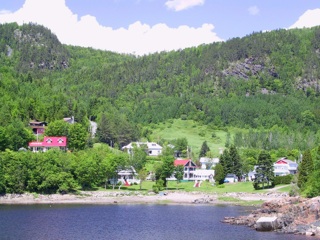

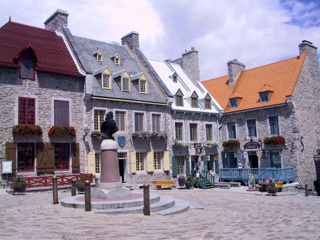
So, on July 1 (Canada Day, see above) we headed out the south shore of the Seaway, heading for the Gaspe Peninsula, of which we had heard much and could hardly wait to visit for ourselves. We passed through small towns filled with lilac trees and huge stacks of cordwood ready to burn next winter. While still close to Quebec City the seashore villages are ready for the summer’s tourists, with lots of B&Bs, outdoor cafes, bike trails along the coastline. The coast is rocky, but flat quite a ways inland at this point; it all reminded us of the Mendocino area, or perhaps Bodega Bay and Bolinas.
So what’s the big deal about the Gaspe Peninsula? Well, get out your maps and let’s take a look. The peninsula is a huge headland that sticks out a long ways into the sea, dividing the north shore of the St. Lawrence from the Province of New Brunswick. It is very rugged, very stark, with two national parks most of the way out. From Quebec City it is about 600 miles around the peninsula to where you can cross into New Brunswick, with only a couple of roads that cross the mountains that make up the headland. It is gorgeous, remote, and we couldn’t wait to get there.

All along the Gaspe, we kept passing fuel stops called Gaz-O-Bar; would you buy gas from them?
We were now on the far eastern edge of the Eastern Time Zone, and as far north as we will get until Newfoundland. It was also just after the summer equinox so it was getting light about 4:00 am and staying light until after 10:00 at night; great sunsets on the water; we have no idea about the sunrises. As you go along the Gaspe, you feel like you are on the edge of the world. You go through tiny towns, little fishing villages wherever there is a bay. But little else is happening. The hills are lush and verdant, more so than we would have thought in an area this rugged. The headland has been folded and twisted in the geologic past, and where the rock is exposed it is very dramatic.
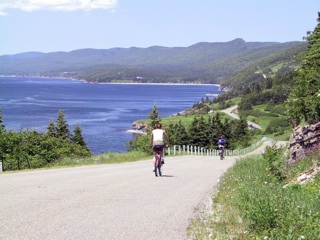
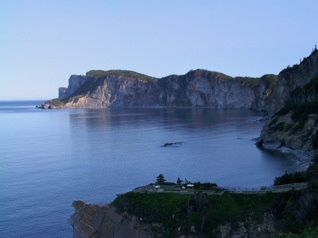
Before leaving Quebec Province, we made one last stop at Ristagouche, an historic site detailing a doomed expedition of French trying to come to the aid of their beleaguered brethren at the time of the fall of Quebec City in 1759. It was a lovely site, and they had some sections of one of the ships that was involved. We thought it was cool. As we’ve mentioned before, Canada generally does a really excellent job with their national parks and historic sites.
We were both sad and happy to leave Quebec Province. We loved the countryside and enjoyed the people. We admired the spirit of independence and patriotism evident everywhere with both national and provincial flags flying in the front lawns of homes just everywhere. But, we did have a problem with the lack of English information on the highway signage in what is, when all is said and done, an English speaking country. This could be dangerous in spots such as the rainy day traveling through a forested area when we saw numerous very large signs saying “Alerte! Originaux”. It was only the following week, seeing similarly worded bilingual signs in New Brunswick that we figured out we were being warned of the extreme danger of caribou on the highway.
So, with sighs of various sorts, we crossed over the bridge, and entered New Brunswick.
At this point we’ll interject a brief discussion of our communications difficulties here in Canada. We thought we’d had things pretty well under control coming in, but the three-plus weeks since leaving the US had shown us that none of our telephone capabilities would work after all. We, of course, have a cell phone that serves us very well for communications in the states. We not only use it as a phone, but do most of our e-mailing on it as well. We knew that Verizon has a North American plan that would cover us in Canada, and all we had to do was make a quick and easy call to the happy, problem-solving folks at Customer Service and all will be well. NOT! The CS folks were unfailingly happy, or at least sounded that way, but THERE WAS NO HOPE. Most replies started with “I can help you with that Mr. Howe, now, where exactly are you?.. Oh, where’s that?.” Apparently New Brunswick and Nova Scotia are not actually part of North America as we had foolishly assumed… By this point in the conversation I didn’t even dare mention Newfoundland. Well, okay, so we’ll just use the phone very sparingly – at .69 per minute roaming charges – WRONG AGAIN! It turns out our cell phone wouldn’t work up here at all; Verizon could not be of any help; we put the cell phone plan on hold for the rest of the summer. But, we are nothing if not experienced, resourceful twenty-first century travelers; we bought a pre-paid phone card and declared that we would just use pay phones. PARDON, MONSIEUR! But your English-speaking AT&T phone card will not work in Quebec, non, non, non. Okay, we bought another card from the phone company that covers eastern Quebec province – not even the whole province mind you – and were fine for that day at least. They didn’t speak any English either, but pointing is the one universal language. We subsequently learned that each area has a different company and they don’t all talk to each other, and they certainly don’t talk to Verizon. So we have a total of three phone cards, and sometimes we can make phone calls; and some times we can’t. C’est la vie. Actually, the story is considerably longer and less interesting than this, but we’re sure you get the drift of things.
Once again, the library system comes to the rescue as the only reliable way for us to keep in touch with the outside world. Here, as in the states, libraries are alive and well, albeit with limited hours of operation, and consistently impress us with how helpful and busy they are. They all have computers to pick up e-mail (with signs on the wall saying “Don de la Fondation Bill & Melissa Gates”). As you enter a province, at the visitor’s center there is always a pamphlet letting you know where all the internet access sites are, and they are abundant. So we’re getting by just fine. Mail is interesting, as we try and figure out where we will be in about 10 days (we’ve been told that’s about right, although so far the mail has arrived in 7 days).
Good old New Brunswick is sort of the forgotten province of eastern Canada. Most of the “really good stuff” is somewhere else, and you have to go through NB to get there. But that’s not really fair. You cross the bridge, and you’re in Campbellton, as English a town as you could ask for. We could now talk to someone easily, the NB flag looks English (as opposed to the Quebec flag which is blue and white and has fleur-de-lys symbols on it), and we started hearing accents more like what one expects in Canada, eh!
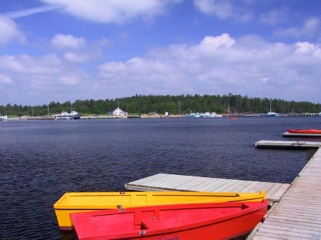
The folks next to us were preparing for a wedding the coming weekend, and tons of family (everyone seemed to live right there in Val-Comeau) dropped by to chat, including bride and groom, and it was a big party the whole time we were camped there. We could see the church across the water, and the reception would be nearby. The folks were lovely and friendly, just like everyone we’ve met this summer.
This area shouldn’t have held us long; we were anxious to get to Prince Edward Island. But we developed a bad tire, and had to wait an extra three days in Tracadie-Sheila (no, it’s pronounced like Shi-la, as if there were no E) to have replacements shipped to us from Montreal. We had the “Got the Need a Pneu/Tire Blues.” Tire being Pneu in French, we parked a couple of nights at OK Pneus (we pronounce the P, they don’t) while we waited, saw everything the area had to offer, except the Peat Bog Festival and the Brussels Sprouts Festival, got new tires, and shoved off.
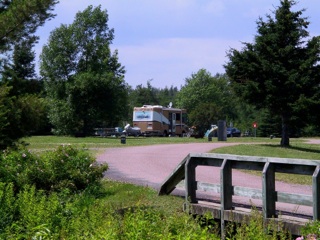
Finally, we were ready to head up to the bridge to PEI, but first, but first, we had to run over into Nova Scotia and get our mail. On the way Rick had a heady experience with the Women’s Resource Center in Truro (trying to find a computer where we could print some of our incoming messages), but that will have to wait for another message. Mail in hand, we headed for the bridge.
There are two ways to get to Prince Edward Island (PEI). You can take a ferry from Nova Scotia, which costs money, or you can go back into New Brunswick and take the new Confederation Bridge, which only costs money when you leave. So logic, and a plan, says you backtrack, cross the bridge to visit the island, and then take the ferry to Nova Scotia when you leave, because that’s where you’re headed next. So we did, across a nine-mile-long bridge.
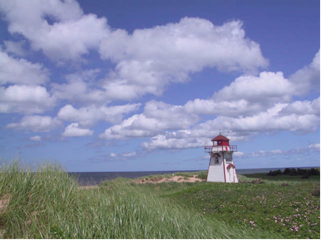
We’ve had some enchanting experiences here on PEI, meeting locals, buying strawberries and local new potatoes at the farm stands, and even visiting a spot that took our breath away: Howe’s Point. We sought it out because of the name, but found ourselves in a deserted area with a splendid view of the water and bluffs on three sides; we began wondering just how bad were the winters here, anyway?
This is the year of the 400th anniversary of the arrival of the French in Canada, which signaled the first real development. The Acadians are their descendants. There’s a large Acadian presence here on PEI and it is well celebrated. We spent a grand day in Rustico, at their Rendez-Vous. It was complete with a show put on by the locals in the afternoon, filled with little girls doing step-dancing, fiddlers, etc. A big name locally is Gallant, and at one point “The Gallant Generations” were on stage with about 25 of them stomping away having a wonderful time. It was great.
Canada recycles better than we do in the United States, and PEI does it the best of all. When we arrived at one campground, we were handed 4 bags. Two of them were for specific kinds of recycling, one was for actual “waste,” and the last was one for “compost”; and it was biodegradable. It was very exciting to see.

This area seems to have more redheads than anywhere else in the world! Shouldn’t be surprising, given that the original settlers were Scotch-Irish and French; makes us want to get to England, now. And again, the locals are great. The other day, we were leaving a parking lot after getting a bite to eat, and stopped to admire a Harley Davidson in the parking lot. The owner walked up, we started chatting about where we were from and found out he had lived in San Miguel for several years before coming back here. San Miguel for lord’s sake! No one lives in San Miguel! Except Harry Ovitt; how is he doing, anyway?
Getting a prescription filled in Canada was also a new adventure. We knew it would work, and we had the paper in hand, direct from the doctor in SLO. Walked into the pharmacy, to find out it needed to be countersigned by a Canadian doctor. So we went to a clinic, waited a bit, met the doctor and he signed it. It’s now being filled at the pharmacy and we’ll pick it up tomorrow. And yes, there is a substantial savings over getting the same pills at home. (Disregarding the cost of the trip, of course…..)
We’ve been on PEI for more than a week now, and plan to leave tomorrow after sending this message and picking up pills. We’ll head for the ferry to Nova Scotia and be on to the next adventure. Rick has taken some incredible pictures of our time in eastern Canada so far, and we’d love to include far more than we can; we hope the attached will give you some sense of how really lovely it is here. As you can see, we are having a wonderful summer, and hope you are as well. We are in excellent computer contact, and would love to hear back from you; let us know what you’re up to.
Oh. Pamplemousse? It’s our favorite new French word, and no, it’s not some sort of Argentinian antelope… it means grapefruit.
Rick & Kathy and the two Shedders

